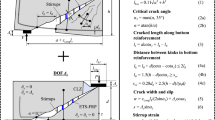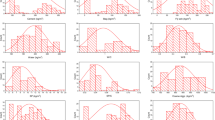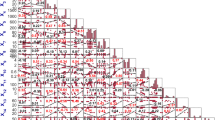Abstract
With the development of reinforced concrete bridges, the fatigue problem of concrete has attracted extensive attention. Failure occurs when concrete is subjected to cyclic compression that is less than the static compressive strength of concrete after a certain amount of cyclic loading (fatigue life). Compared to traditional methods with shortage of low accuracy, resulting uncertain safety problem, to address this issue, we utilized gradient boosting regression tree (GBRT) and multiple linear regression (MLR) to predict the fatigue life of concrete under repeated compression based on the collated 275 sets of experimental data. All prediction results were compared with that calculated by the existing European codes. Results analysis reveal that both proposed GBRT and MLR models have lower errors and higher correlation coefficients than that of existing formula/code models. Furthermore, the prediction accuracy of the GBRT model can be improved by using the existing classical formulas to reconstruct the features and selecting suitable features by ranking the feature importance, without increasing the number of features. Experimental results reveal that GBRT model can achieve the best performance with lowest RMSE and highest R2. Moreover, the sensitivity analysis revealed that the proposed GBRT model is insensitive to input characteristics of fatigue life, which can be used for accurate calculation and design analysis of concrete compressive fatigue life, providing important reference value for formulating concrete technical design specification based on fatigue life.













Similar content being viewed by others
References
Yadav IN, Thapa KB (2020) Fatigue damage model of concrete materials. Theor Appl Fract Mech 108:102578. https://doi.org/10.1016/j.tafmec.2020.102578
Shiri S, Pourgol-Mohammad M, Yazdani M (2014) Probabilistic assessment of fatigue life in fiber reinforced composites. In: ASME International mechanical engineering congress and exposition. American Society of Mechanical Engineers, p. V014T08A018
Suzuki T, Ohtsu M, Shigeishi M (2007) Relative damage evaluation of concrete in a road bridge by AE rate-process analysis. Mater Struct 40:221–227. https://doi.org/10.1617/s11527-006-9133-9
Su HZ, Tong JJ, Hu J, Wen ZP (2013) Experimental study on AE behavior of hydraulic concrete under compression. Meccanica 48:427–439. https://doi.org/10.1007/s11012-012-9641-3
Choi S-J, Mun J-S, Yang K-H, Kim S-J (2016) Compressive fatigue performance of fiber-reinforced lightweight concrete with high-volume supplementary cementitious materials. Cem Concr Compos 73:89–97. https://doi.org/10.1016/j.cemconcomp.2016.07.007
Shah SP, Chandra S (1970) Fracture of concrete subjected to cyclic and sustained loading. In: Journal Proceedings. pp 816–827
Fitzka M, Karr U, Granzner M et al (2021) Ultrasonic fatigue testing of concrete. Ultrasonics 116:106521. https://doi.org/10.1016/j.ultras.2021.106521
Ruiz G, Medeiros A, Zhang XX (2011) Experimental study of loading frequency effect on compressive fatigue behavior of plain and fiber reinforced concretes. Anales de Mecánica de la Fractura 29(9):535–540
Baktheer A, Hegger J, Chudoba R (2019) Enhanced assessment rule for concrete fatigue under compression considering the nonlinear effect of loading sequence. Int J Fatigue 126:130–142. https://doi.org/10.1016/j.ijfatigue.2019.04.027
Sinaie S, Heidarpour A, Zhao XL, Sanjayan JG (2015) Effect of size on the response of cylindrical concrete samples under cyclic loading. Constr Build Mater 84:399–408. https://doi.org/10.1016/j.conbuildmat.2015.03.076
Comi C, Kirchmayr B, Pignatelli R (2012) Two-phase damage modeling of concrete affected by alkali–silica reaction under variable temperature and humidity conditions. Int J Solids Struct 49:3367–3380
Liu Y, Pang J, Yao W (2021) Fatigue performance of rubber concrete in hygrothermal environment. Adv Mater Sci Eng 2021:1–11
Tue NV, Mucha S (2006) Fatigue behaviour of high strength concrete under compression. Bautechnik 83:497–504
Hsu TTC (1981) Fatigue of plain concrete. J Proc 78(4):292–305
Kim JK, Kim YY (1996) Experimental study of the fatigue behavior of high strength concrete. Cem Concr Res 26(10):1513–1523. https://doi.org/10.1016/0008-8846(96)00151-2
Cui K, Xu L, Li X et al (2021) Fatigue life analysis of polypropylene fiber reinforced concrete under axial constant-amplitude cyclic compression. J Clean Prod 319:128610. https://doi.org/10.1016/j.jclepro.2021.128610
Tarifa M, Ruiz G, Poveda E et al (2018) Effect of uncertainty on load position in the fatigue life of steel-fiber reinforced concrete under compression. Mater Struct 51:1–11
Cachim PB, Figueiras JA, Pereira PAA (2002) Fatigue behavior of fiber-reinforced concrete in compression. Cem Concr Compos 24:211–217
Tepfers R, Kutti T (1979) Fatigue strength of plain, ordinary, and lightweight concrete. In: Journal Proceedings. pp. 635–652
Onoue K, Matsushita H (2012) Reduction mechanisms of fatigue strength of concrete under compression due to permeation of liquids. Constr Build Mater. https://doi.org/10.1016/j.conbuildmat.2012.07.010
Ma C-K, Awang AZ, Omar W (2018) Eccentricity-based design procedure of confined columns under compression and in-plane bending moment. Measurement 129:11–19. https://doi.org/10.1016/j.measurement.2018.07.012
Viswanath S, LaFave JM, Kuchma DA (2021) Concrete compressive strain behavior and magnitudes under uniaxial fatigue loading. Constr Build Mater 296:123718. https://doi.org/10.1016/j.conbuildmat.2021.123718
Zhang Q, Wang L (2021) Investigation of stress level on fatigue performance of plain concrete based on energy dissipation method. Constr Build Mater 269:121287. https://doi.org/10.1016/j.conbuildmat.2020.121287
Code Committee 351 001 (2009) Regulations for Concrete- Bridges- Structural requirements and calculation methods. NEN 6723:2009
CEN (2011) Eurocode 2: design of concrete structures – Concrete bridges – Design and detailing rules. NEN-EN 1992-2+C1:2011. Comité Européen de Normalisation, Brussels, Belgium
Fib (2012) Model Code 2010: Final draft. Fib Bulletin 65–66. International Federation for Structural Concrete, Lausanne, Switzerland
Lantsoght EOL, Van Der Veen C, De Boer A (2016) Proposal for the fatigue strength of concrete under cycles of compression. Constr Build Mater 107:138–156. https://doi.org/10.1016/j.conbuildmat.2016.01.007
Abambres M, Lantsoght EOL (2019) ANN-based fatigue strength of concrete under compression. Materials (Basel). https://doi.org/10.3390/ma12223787
Liu W, Wang Z, Liu X et al (2017) A survey of deep neural network architectures and their applications. Neurocomputing 234:1–31. https://doi.org/10.1016/j.neucom.2016.12.038
Khademi F, Jamal SM, Deshpande N, Londhe S (2016) Predicting strength of recycled aggregate concrete using artificial neural network, Adaptive neuro-fuzzy inference system and multiple linear regression. Int J Sustain Built Environ. https://doi.org/10.1016/j.ijsbe.2016.09.003
Khademi F, Akbari M, Jamal SM, Nikoo M (2017) Multiple linear regression, artificial neural network, and fuzzy logic prediction of 28 days compressive strength of concrete. Front Struct Civ Eng. https://doi.org/10.1007/s11709-016-0363-9
Jiang C-S, Liang G-Q (2021) Modeling shear strength of medium- to ultra-high-strength concrete beams with stirrups using SVR and genetic algorithm. Soft Comput 25(16):10661–10675. https://doi.org/10.1007/s00500-021-06027-2
Min C (2019) Multiple linear regression models. Applied Econometrics. Routledge, New York and London
Chen T, Guestrin C (2016) XGBoost: a scalable tree boosting system. In: Proceedings of the ACM SIGKDD international conference on knowledge discovery and data mining
Friedman JH (2001) Greedy function approximation: a gradient boosting machine. Ann Stat 29:1189–1232. https://doi.org/10.1214/aos/1013203451
Cai J, Xu K, Zhu Y et al (2020) Prediction and analysis of net ecosystem carbon exchange based on gradient boosting regression and random forest. Appl Energy 262:114566. https://doi.org/10.1016/j.apenergy.2020.114566
Nunez I, Marani A, Nehdi ML (2020) Mixture optimization of recycled aggregate concrete using hybrid machine learning model. Materials (Basel). https://doi.org/10.3390/ma13194331
Rathakrishnan V, Bt. Beddu S, Ahmed AN (2022) Predicting compressive strength of high-performance concrete with high volume ground granulated blast-furnace slag replacement using boosting machine learning algorithms. Sci Rep. https://doi.org/10.1038/s41598-022-12890-2
Feng DC, Wang WJ, Mangalathu S et al (2021) Implementing ensemble learning methods to predict the shear strength of RC deep beams with/without web reinforcements. Eng Struct. https://doi.org/10.1016/j.engstruct.2021.111979
Zheng D, Wu R, Sufian M et al (2022) Flexural strength prediction of steel fiber-reinforced concrete using artificial intelligence. Materials (Basel). https://doi.org/10.3390/ma15155194
Degtyarev VV (2022) Machine learning models for predicting bond strength of deformed bars in concrete. ACI Struct J. https://doi.org/10.14359/51734833
Friedman JH (2002) Stochastic gradient boosting. Comput Stat Data Anal. https://doi.org/10.1016/S0167-9473(01)00065-2
Saucedo L, Rena CY, Medeiros A et al (2013) A probabilistic fatigue model based on the initial distribution to consider frequency effect in plain and fiber reinforced concrete. Int J Fatigue 48:308–318
Hohberg R (2004) About the fatigue behavior of concrete. TU Berlin, Berlin
Hordijk DA (1994) Comparative research in material properties of gravel concrete and limestone concrete, Phase II: Fatigue. Report 94-CON-R0270. TNO, Delft, The Netherlands
Fehling E, Schmidt M, Teichmann T, Bunje K, Bornemann R, BM (2005) Development, durability and calculation of Ultra High Performance Concrete (UHPC), Forschungsbericht DFG FE 497/1–1. Universität Kassel
CUR Committee C 33 (1983) Fatigue of Concrete, Part 1: Compressive Stresses, CUR Report 112. Dutch
CUR Committee C 33 (1993) Fatigue of Concrete, Part 4: Compressive Stresses, CUR Report 163. Dutch
Hordijk D, Wolsink G, De Vries J (1995) Fracture and fatigue behaviour of a high strength limestone concrete as compared to gravel concrete. Heron (Delft) 40(2):125–146
Klausen D (1978) Strength and damage of concrete after repeated stress cycles
Lohaus L, Anders S (2006) High-cycle fatigue of ultra-high performance concrete–fatigue strength and damage development. In: Proceedings of the 2nd International Congress, Naples, Italy. pp. 5–8
Petkovic G, Lenschow R, Stemland H, Rosseland S (1990) Fatigue of high-strength concrete. ACI Spec Publ 121(11):505–525
Wefer M (2010) Material behavior and Experimental Results of ultra-high strength concrete subjected to uniaxial fatigue
Huang W (2017) The frequency domain estimate of fatigue damage of combined load effects based on the rain-flow counting. Mar Struct 52:34–49. https://doi.org/10.1016/j.marstruc.2016.11.004
Hair JF, Black WC, Babin BJ, Anderson RE (2010) Multivariate data analysis. In: Vectors
Banga A, Ahuja R, Sharma SC (2021) Performance analysis of regression algorithms and feature selection techniques to predict PM2.5 in smart cities. Int J Syst Assur Eng Manag. https://doi.org/10.1007/s13198-020-01049-9
Costa EB, Fonseca B, Santana MA et al (2017) Evaluating the effectiveness of educational data mining techniques for early prediction of students’ academic failure in introductory programming courses. Comput Human Behav 73:247–256. https://doi.org/10.1016/j.chb.2017.01.047
Acknowledgements
This study was co-supported by Guangxi Basic Ability Promotion Project for Young and Middle-aged Teachers (Grant No. 2023KY0266), and Guangxi Key Laboratory of Green Building Materials and Construction Industrialization (No. 22-J-21-2). The authors would like to thank them.
Author information
Authors and Affiliations
Corresponding author
Ethics declarations
Conflict of interest
The authors declare that they have no conflict of interest.
Human and animal rights
This article does not include any studies of human participants performed by the authors.
Additional information
Publisher's Note
Springer Nature remains neutral with regard to jurisdictional claims in published maps and institutional affiliations.
Rights and permissions
Springer Nature or its licensor (e.g. a society or other partner) holds exclusive rights to this article under a publishing agreement with the author(s) or other rightsholder(s); author self-archiving of the accepted manuscript version of this article is solely governed by the terms of such publishing agreement and applicable law.
About this article
Cite this article
Liang, GQ., Chen, X., Jiang, BY. et al. Fatigue life prediction of concrete under cyclic compression based on gradient boosting regression tree. Mater Struct 56, 172 (2023). https://doi.org/10.1617/s11527-023-02262-1
Received:
Accepted:
Published:
DOI: https://doi.org/10.1617/s11527-023-02262-1




